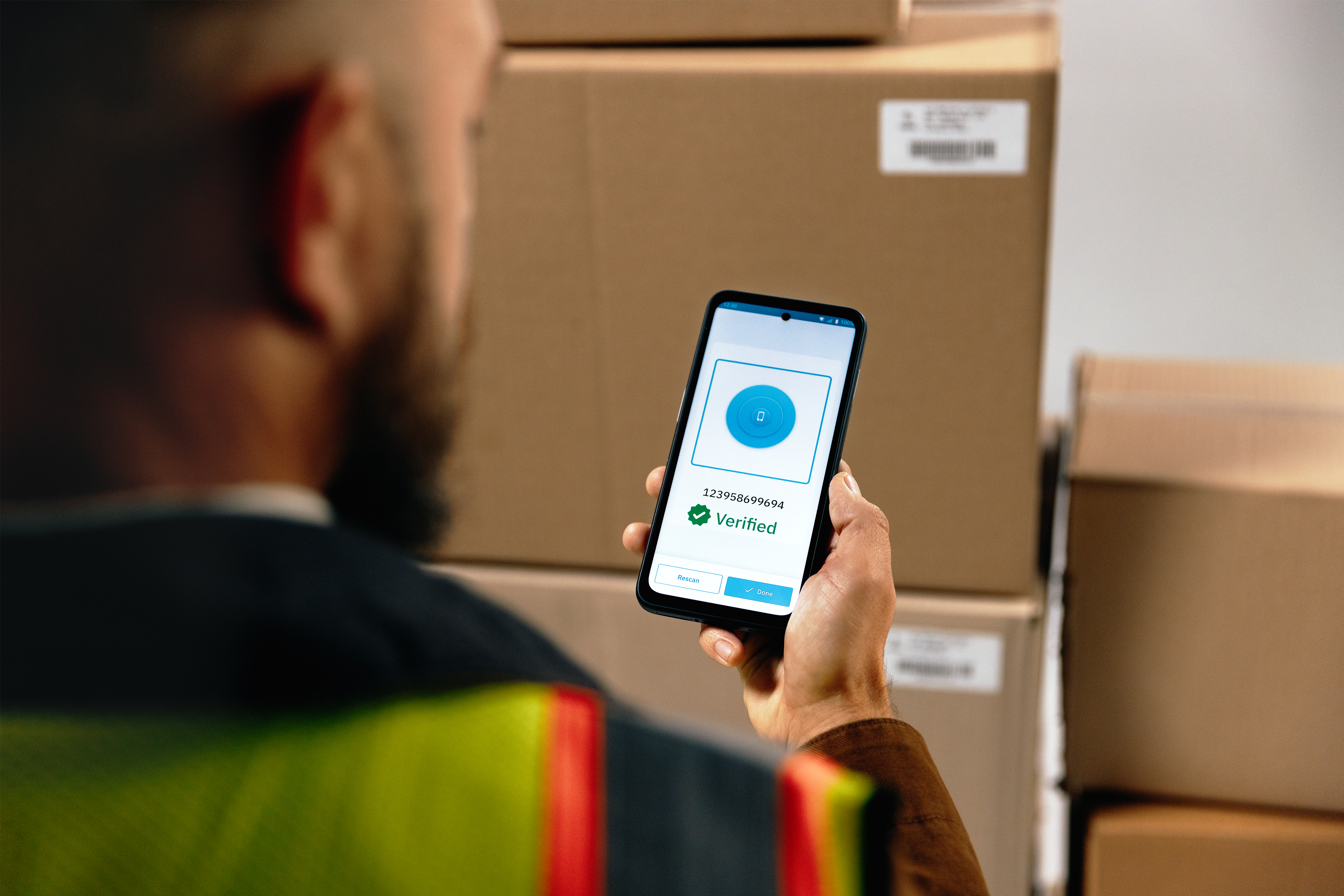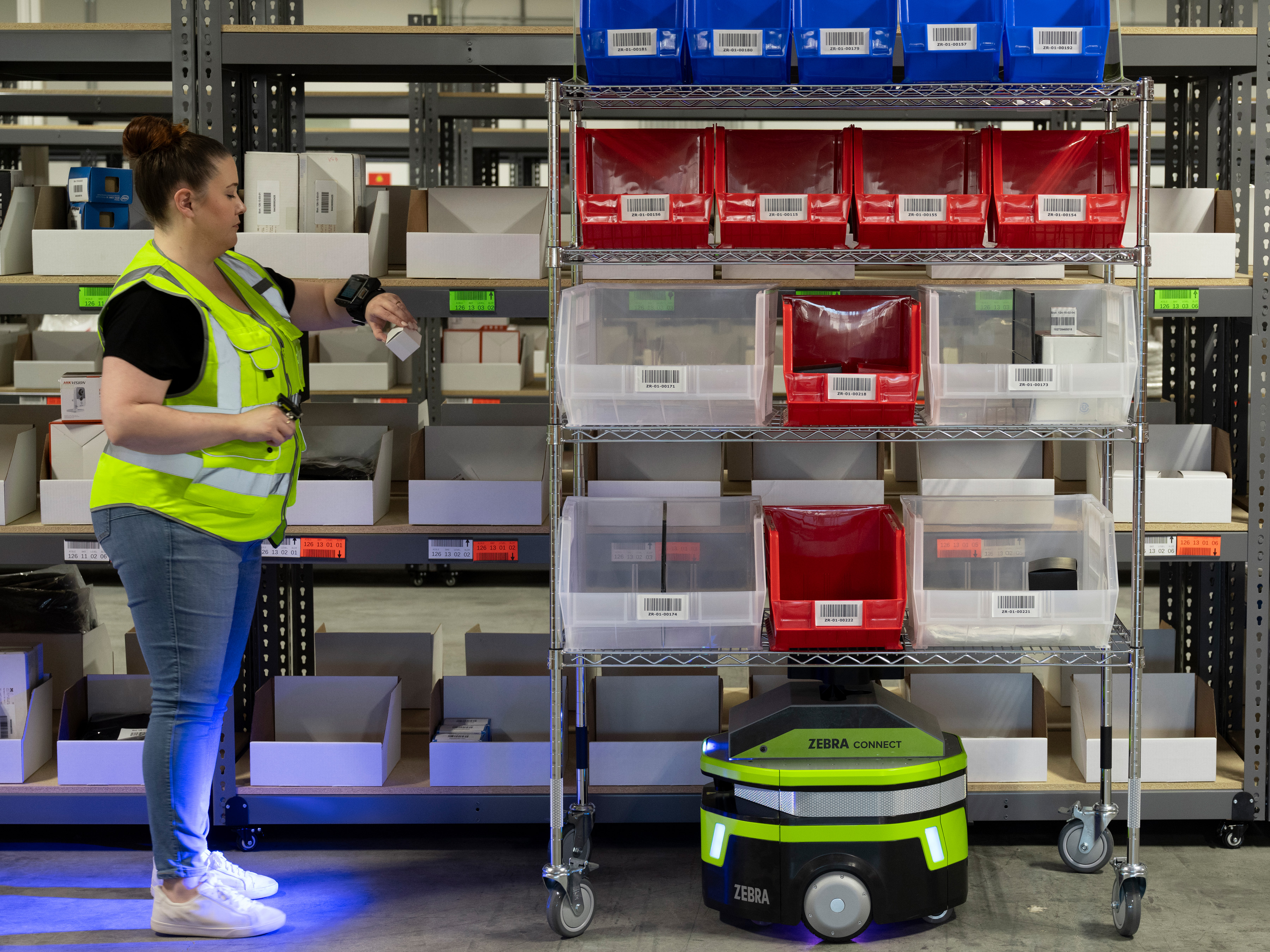Transform retail operations with Zebra’s retail technology solutions, featuring hardware and software for improving inventory management and empowering teams.
Streamline operations with Zebra’s healthcare technology solutions, featuring hardware and software to improve staff collaboration and optimize workflows.
Enhance processes with Zebra’s manufacturing technology solutions, featuring hardware and software for automation, data analysis, and factory connectivity.
Zebra’s transportation and logistics technology solutions feature hardware and software for enhancing route planning, visibility, and automating processes.
Learn how Zebra's public sector technology solutions empower state and local governments to improve efficiency with asset tracking and data capture devices.
Zebra's hospitality technology solutions equip your hotel and restaurant staff to deliver superior customer and guest service through inventory tracking and more.
Zebra's market-leading solutions and products improve customer satisfaction with a lower cost per interaction by keeping service representatives connected with colleagues, customers, management and the tools they use to satisfy customers across the supply chain.
Empower your field workers with purpose-driven mobile technology solutions to help them capture and share critical data in any environment.
Zebra's range of Banking technology solutions enables banks to minimize costs and to increase revenue throughout their branch network. Learn more.
Zebra's range of mobile computers equip your workforce with the devices they need from handhelds and tablets to wearables and vehicle-mounted computers.
Zebra's desktop, mobile, industrial, and portable printers for barcode labels, receipts, RFID tags and cards give you smarter ways to track and manage assets.
Zebra's 1D and 2D corded and cordless barcode scanners anticipate any scanning challenge in a variety of environments, whether retail, healthcare, T&L or manufacturing.
Zebra's extensive range of RAIN RFID readers, antennas, and printers give you consistent and accurate tracking.
Choose Zebra's reliable barcode, RFID and card supplies carefully selected to ensure high performance, print quality, durability and readability.
Zebra's location technologies provide real-time tracking for your organization to better manage and optimize your critical assets and create more efficient workflows.
Zebra's rugged tablets and 2-in-1 laptops are thin and lightweight, yet rugged to work wherever you do on familiar and easy-to-use Windows or Android OS.
With Zebra's family of fixed industrial scanners and machine vision technologies, you can tailor your solutions to your environment and applications.
Zebra’s line of kiosks can meet any self-service or digital signage need, from checking prices and stock on an in-aisle store kiosk to fully-featured kiosks that can be deployed on the wall, counter, desktop or floor in a retail store, hotel, airport check-in gate, physician’s office, local government office and more.
Adapt to market shifts, enhance worker productivity and secure long-term growth with AMRs. Deploy, redeploy and optimize autonomous mobile robots with ease.
Discover Zebra’s range of accessories from chargers, communication cables to cases to help you customize your mobile device for optimal efficiency.
Zebra's environmental sensors monitor temperature-sensitive products, offering data insights on environmental conditions across industry applications.
Enhance frontline operations with Zebra’s AI software solutions, which optimize workflows, streamline processes, and simplify tasks for improved business outcomes.
Zebra Workcloud, enterprise software solutions boost efficiency, cut costs, improve inventory management, simplify communication and optimize resources.
Keep labor costs low, your talent happy and your organization compliant. Create an agile operation that can navigate unexpected schedule changes and customer demand to drive sales, satisfy customers and improve your bottom line.
Drive successful enterprise collaboration with prioritized task notifications and improved communication capabilities for easier team collaboration.
Get full visibility of your inventory and automatically pinpoint leaks across all channels.
Reduce uncertainty when you anticipate market volatility. Predict, plan and stay agile to align inventory with shifting demand.
Drive down costs while driving up employee, security, and network performance with software designed to enhance Zebra's wireless infrastructure and mobile solutions.
Explore Zebra’s printer software to integrate, manage and monitor printers easily, maximizing IT resources and minimizing down time.
Make the most of every stage of your scanning journey from deployment to optimization. Zebra's barcode scanner software lets you keep devices current and adapt them to your business needs for a stronger ROI across the full lifecycle.
RFID development, demonstration and production software and utilities help you build and manage your RFID deployments more efficiently.
RFID development, demonstration and production software and utilities help you build and manage your RFID deployments more efficiently.
Zebra DNA is the industry’s broadest suite of enterprise software that delivers an ideal experience for all during the entire lifetime of every Zebra device.
Advance your digital transformation and execute your strategic plans with the help of the right location and tracking technology.
Boost warehouse and manufacturing operations with Symmetry, an AMR software for fleet management of Autonomous Mobile Robots and streamlined automation workflows.
The Zebra Aurora suite of machine vision software enables users to solve their track-and-trace, vision inspection and industrial automation needs.
Zebra Aurora Focus brings a new level of simplicity to controlling enterprise-wide manufacturing and logistics automation solutions. With this powerful interface, it’s easy to set up, deploy and run Zebra’s Fixed Industrial Scanners and Machine Vision Smart Cameras, eliminating the need for different tools and reducing training and deployment time.
Aurora Imaging Library™, formerly Matrox Imaging Library, machine-vision software development kit (SDK) has a deep collection of tools for image capture, processing, analysis, annotation, display, and archiving. Code-level customization starts here.
Aurora Design Assistant™, formerly Matrox Design Assistant, integrated development environment (IDE) is a flowchart-based platform for building machine vision applications, with templates to speed up development and bring solutions online quicker.
Designed for experienced programmers proficient in vision applications, Aurora Vision Library provides the same sophisticated functionality as our Aurora Vision Studio software but presented in programming language.
Aurora Vision Studio, an image processing software for machine & computer vision engineers, allows quick creation, integration & monitoring of powerful OEM vision applications.
Adding innovative tech is critical to your success, but it can be complex and disruptive. Professional Services help you accelerate adoption, and maximize productivity without affecting your workflows, business processes and finances.
Zebra's Managed Service delivers worry-free device management to ensure ultimate uptime for your Zebra Mobile Computers and Printers via dedicated experts.
Find ways you can contact Zebra Technologies’ Support, including Email and Chat, ask a technical question or initiate a Repair Request.
Zebra's Circular Economy Program helps you manage today’s challenges and plan for tomorrow with smart solutions that are good for your budget and the environment.
The Zebra Knowledge Center provides learning expertise that can be tailored to meet the specific needs of your environment.
Zebra has a wide variety of courses to train you and your staff, ranging from scheduled sessions to remote offerings as well as custom tailored to your specific needs.
Build your reputation with Zebra's certification offerings. Zebra offers a variety of options that can help you progress your career path forward.
Build your reputation with Zebra's certification offerings. Zebra offers a variety of options that can help you progress your career path forward.

How to Improve Team Efficiency Through Scrum
Let’s talk about how Scrum compares to Waterfall project management, what it has in common with Agile, and how you can start using Scrum to keep your projects on time and on budget.
You may have heard of Scrum but aren’t sure what it is or how it benefits the business. Or perhaps you use it but others in your organization don’t understand it.
As a certified Scrum master, I’d like to share a bit about how I’ve used Scrum to transform my work and my team’s working model to improve efficiency, among other things. I truly believe it can help you once you (or others in your organization) understand its purpose and how it’s meant to be applied.
What is Scrum?
Scrum is a project management framework that emphasizes teamwork, accountability and iterative progress toward a well-defined goal. It’s three pillars are transparency, inspection and adaptation.
That’s why the framework begins with a simple premise: Start with what you see or know. After that, track the progress and tweak as necessary.
Essentially, each person using Scrum commits to achieving short-term goals within a designated time frame, welcoming and adapting to change, and working collaboratively.
This, of course, requires openness and transparency with others about work, progress, and issues. Respecting each other’s decisions, experience, and diversity is also critical. Moreover, being courageous is essential, as it takes courage to accept change, take risks, and find optimized solutions. However, if you make this commitment, the benefits can be exponential.
What are Scrum’s Benefits?
I have recognized many benefits of using the Scrum approach for projects. Here are a few of the most notable:
1. Quicker release of a useable product to customers/end users: Scrum allows simultaneous work which enables quicker coding and testing compared to sequential work. Programmers and testers work “on the fly,” making adjustments and testing as they go.
2. A higher-quality product: Scrum helps you define and elaborate on requirements just in time through continuous feedback, which means each person on your team can adjust their work in the moment instead of waiting until the product is done. This keeps product knowledge relevant and enables continuous enhancement as requirements change and new technology features and capabilities emerge. (There is often simultaneous innovation occurring on the baseline platform while you’re iterating on your system/solution. There are also net new technology standards, models, and tools hitting the market every day that you may need or want to incorporate while developing or configuring your solution.)
3. Higher productivity rates and better employee morale: Team collaboration and pair programming lead to faster, higher-quality work. Your development team stays focused on completing prioritized tasks that deliver business value, which fosters a sense of accomplishment and boosts morale.
4. Lower project costs: Scrum delivers value faster than traditional methods and helps to keep labor costs down. You’ll solicit stakeholder feedback early on during sprint reviews, which allows for immediate course corrections and reduces costly changes later in the process. Automation and up-front testing also minimize wasted work and help expedite deployments.
5. Greater ability to incorporate changes as they occur: I’ve mentioned this a couple times already, but I want to put an exclamation point on this benefit. Unlike traditional methods where the project scope is fixed, Scrum allows you to continuously evolve your scope as you test and learn without suffering the typical consequences of scope creep. With Scrum, the time and cost for your project stay constant even if you make changes to the design or build plan.
6. Better user satisfaction: The people who will be using this platform or system to do their jobs will receive useable portions of the completed product quicker. They won’t have to wait for years to get the tools they need right now. Taking an incremental rollout approach also allows for timely feedback to your team so it can ensure the final product meets customer expectations and end-user needs.
7. Improved progress visibility and exposure: Transparency and open communication ensure everyone on your team and the customer side is informed about the project’s status so that the team can accurately identify any issues and predict progress.
8. Maintains focus: The iterative and incremental approach of Scrum helps all teams stay focused on the project goal so you can go-live on time.
If it sounds good so far, let’s talk process – what the experience will be like for everyone involved.
How Does Scrum Work?
Scrum uses short iterations, called sprints, typically lasting no more than two weeks. Each sprint includes four aspects to ensure proper execution:
- Sprint Planning: The team decides what they need to complete in the coming sprint and shares updates or obstacles.
- Daily Scrum: This short standup meeting ensures everyone is on the same page. Team members report on what they did, what they plan on doing and any blockers they face.
- Sprint Review: Team members showcase the work they accomplished during the sprint, celebrate achievements, and gather valuable input.
- Sprint Retrospective: The team reviews their work, identifying what went well and what didn’t go as planned so they can make the next sprint better.
What are the Scrum Roles?
The following roles form the Scrum team:
- Scrum Master: Helps the team skillfully apply Scrum to achieve business value. The Scrum Master is not their manager, project manager, team lead or team representative. Instead, the Scrum Master serves the team by removing impediments, protecting them from outside interference, and helping them adopt Agile development practices.
- Scrum Product Owner: Acts as the customer representative, ensuring the product meets user needs and business objectives. The Product Owner is responsible for maximizing ROI by identifying product features, translating these into a prioritized list for the next sprint and continually re-prioritizing and refining the list. The Product Owner has profit and loss responsibility for the product, assuming it is a commercial product.
- Development team: Cross-functional members who work together to deliver product increments. This team includes software engineers, architects, programmers, analysts, quality assurance (QA) experts, testers, and user interface (UI) designers, all collaborating to achieve sprint goals.
Now, at this point, if you’re familiar with agile, you might be questioning everything I just said.
“This sounds a lot like agile. Are they the same thing? Don’t Scrum Masters drive the agile process?”
This is a common question, and I’m glad you asked.
While they share the same principles, Agile is a project management philosophy while Scrum is the precise framework – the Agile methodology – that you follow to manage the project.
Now you may be asking…
Why Scrum Instead of Waterfall?
One long-lived project management methodology is the Waterfall model, which has dominated software development until recently.
Why the sudden change?
Waterfall’s primary limitation is that it (wrongly) assumes that all the requirements are clearly understood at the beginning of the project. That is rarely the case. As a result of this incorrect assumption…
- Sequential phases don’t accommodate changes easily.
- It’s difficult updating requirements once the project is underway.
- Testing happens too late in the process. That can lead to significant time and budget extensions if bugs are found.
In contrast, Scrum’s iterative and flexible nature allows for continuous feedback, quicker adaptation to changes and higher-quality outcomes.
Think of Scrum as a way for you and your team to accomplish work in small, manageable steps, incorporating continuous experimentation and feedback loops along the way to help you learn. As an Agile framework, it provides just enough structure for you to integrate into your way of working, while adding practices tailored to your specific needs.
Looking to Get Started with Scrum?
The first step is to understand the Scrum framework, as defined in The Scrum Guide, which was introduced in 1995 as a better way for teams to tackle complex problems. I recommend reading insights from Professional Scrum Masters and Trainers (PSTs), who are experts in their field, and exploring resources from Scrum.org to learn how to apply Scrum methodologies to your team.
I’m also happy to answer any questions you may have. You can find me on LinkedIn or email me here.
Zebra Developer Blog
Zebra Developer Blog
Are you a Zebra Developer? Find more technical discussions on our Developer Portal blog.
Zebra Story Hub
Zebra Story Hub
Looking for more expert insights? Visit the Zebra Story Hub for more interviews, news, and industry trend analysis.
Search the Blog
Search the Blog
Use the below link to search all of our blog posts.
Most Recent
Legal Terms of Use Privacy Policy Supply Chain Transparency
ZEBRA and the stylized Zebra head are trademarks of Zebra Technologies Corp., registered in many jurisdictions worldwide. All other trademarks are the property of their respective owners. ©2025 Zebra Technologies Corp. and/or its affiliates.






